This review first appeared in the online inter-disciplinary journal Cercles, where the original can be seen here. The author has reformatted and illustrated it for the Victorian Web, adding links and captions, with the kind permission of the journal. All images except the first, of the book cover, and the last two, taken from our own website, come from the Wellcome Library, London, with many thanks. They are available for reuse, with attribution, on the Creative Commons Licence. Click on all the images to enlarge them.
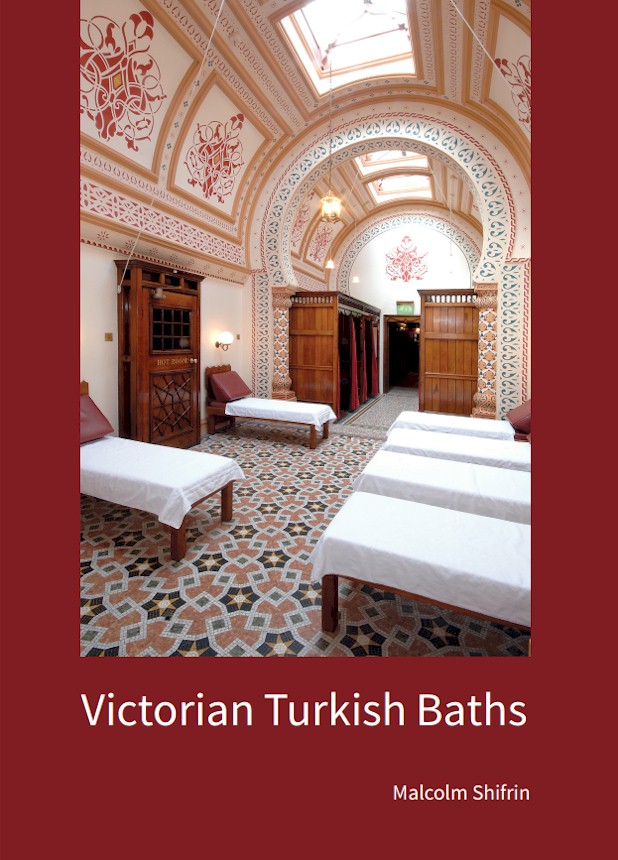
In his preface to Victorian Turkish Baths, Malcolm Shifrin reaches out to anyone who likes any type of spa or hot-air bath, not simply Victorian ones; but his book is so appealing to the eye and so full of fascinating information that those with a more general interest in the Victorian period, or even the simply curious, will also find it a pleasure to read. This is so from the glossary onwards, where one learns, for example, that "shampoo" only came into use in the modern sense from about 1860, before which it referred to a massage. Apart from such unexpected gleanings, many terms here carry usefully through into different areas of specialised knowledge, notably architecture: a stalactite cornice for example, is decorative work in which "niche-like features are projected over those below, suggesting, when used en masse, stalactites" (xvii). It is all made admirably clear, especially because it is so well illustrated.
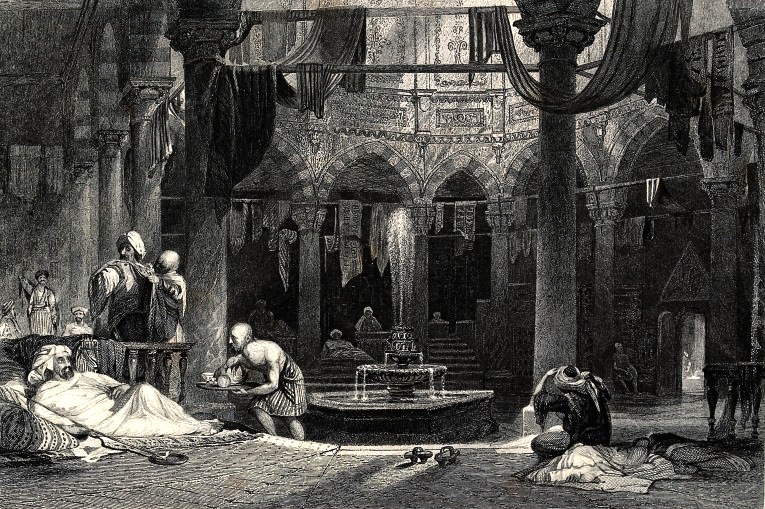
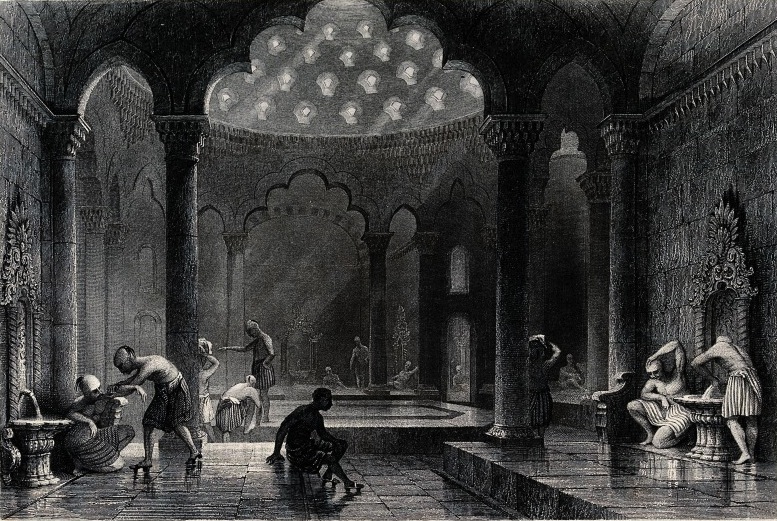
Left: Outer cooling room of a Turkish bath-house. Wood engraving by T.A. Prior after Thomas Allom, from Constantinople and the Scenery of the Seven Churches of Asia Minor (1838). Right: A Turkish bath, in an engraving by M. J. Starling, also after Thomas Allom.
This sets the pace for the full-scale description of Turkish baths, which, Shifrin explains, are not specifically Turkish at all, but are found anywhere where Moorish or Islamic influence appears. The Victorians were the first to import the practice that had, he tells us, fascinated European travellers for centuries. The first one, at Blarney near Cork, was established in 1856. Inspired both by Scotsman David Urquart's The Pillars of Hercules: A Narrative of Travels in Spain and Morocco (1848) and the Irish, London-trained physician, Dr Richard Barter's interest in hydropathy, the idea next caught on in the north of England, and travelled south. There are wonderful evocative subheadings in these opening chapters, like "Barter, Urqhuart, and the beehive-shaped bath," referring to the one first constructed by Barter in Cork, on the lines of Irish sweathouse, and "The baths at B*** attacked," referring to medical opinion that Barter's splendid new baths at Bray exposed clients to dangerous fumes. Despite teething troubles, though, what started as an experiment soon became a movement, until there were facilities of this kind for a whole range of patrons, from those who frequented the Jermyn Street Hammam (which Trollope both enjoyed visiting and wrote about, and which also became a favourite haunt of gays), right down to facilities for animals — not just pampered racehorses, but, bizarrely and sometimes controversially, ailing working horses, distempered cattle and pigs, sheep with ticks, poultry and pets. Sir John Fife, a surgeon, thought that such treatment sweetened the pig's flesh.
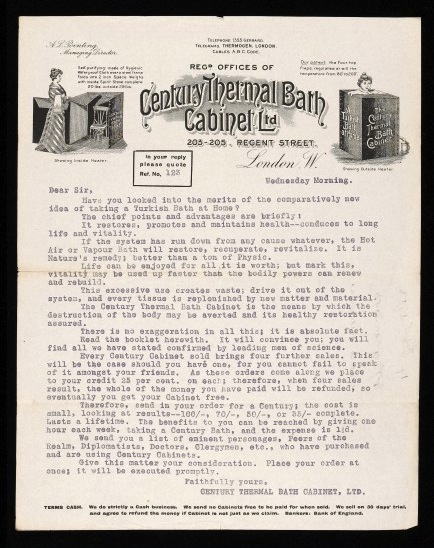
Leaflet and advert concerning the Century Thermal Bath Cabinet or home Turkish bath, 1900, from the Ephemera Collection, Regd. offices of Century Thermal Bath Cabinet Ltd., 203-205, Regent Street, London, W., published by Century Thermal Bath Cabinet Ltd (London, 1900).
For the human client, baths were promoted for other reasons, such as cleanliness and health benefits, and had the advantage, commercially, or even for local authorities, of being quite cheap to run. They could be and were incorporated into larger public bathing facilities, right up until the end of World War II. Bradford Corporation was the first to initiate such provision, says Shifrin carefully, pointing out that by the time theirs opened two others were already being used, one at a Nottingham swimming pool, the other in Bury. They were provided in all sorts of other institutions as well, from workhouses and asylums to hospitals, all the way up to expensive "hydros" and hotels. The Hydro hotel in Llandudno, for example, was offering "FOUR RUSSIAN VAPOUR and TWO COMMODIOUS and WELL-APPOINTED TURKISH BATHS, THE SEAWEED or OZONE bath" from 1873. (This example is not found in the book, but the establishment is featured on Shifrin's even more comprehensive website, from which the book grew, and to which he often encourages his readers to refer, found offsite here). The great new luxury liners of the early twentieth century also provided them, and Shifrin has found a plan and a photograph of the facilities on the Titanic.
Private Turkish baths were, of course, the ultimate in luxury, and could be found behind the closed doors of clubland and in wealthy people's mansions. Naturally, Urquart himself had one in his Hertfordshire home — though this turned out to have a tragic consequence, when his sick child had a fatal fit in his cooling-room. Thomas Owen, a vice-president of the Vegetarian Society, was another who installed his own Turkish bath, extolling its virtues in a verse penned, according to its title, "at midnight, in 200°, February, 1912." It starts evocatively and somewhat alarmingly, "Night after night, at boiling point, / My radiant chamber glows," and then traces the effects by which, at last, "the skin is rid / Of cuticle depraved" (243). Less of a lyricist was another enthusiast, the engineer, inventor and arms supplier Lord Armstrong, whose house at Cragside in Northumberland was the last word in advanced technology, and whose exotic facilities there can still be seen.
Richard Norman Shaw's original design for the bath complex in Cragside is one of the many contemporary illustrations of all kinds that add spice and relish to Shifrin's marvellous compendium. Who was to know that this influential architect ever designed a Turkish Bath? Yet when it came to exteriors, the most spectacular was surely the one designed for Cookridge Road, Leeds, by Cuthbert Brodrick. It had a polychromatic façade with oriental-style windows and parapet, a variety of domes, including a central one like his Corn Exchange in the same city, and a tall, fanciful kind of minaret at the rear. It would have been one of the wonders of Leeds if it had been built as he envisaged, but it underwent various modifications after it left the drawing board, and was finally demolished in 1969. Shifrin's details about this side of his subject are especially welcome.
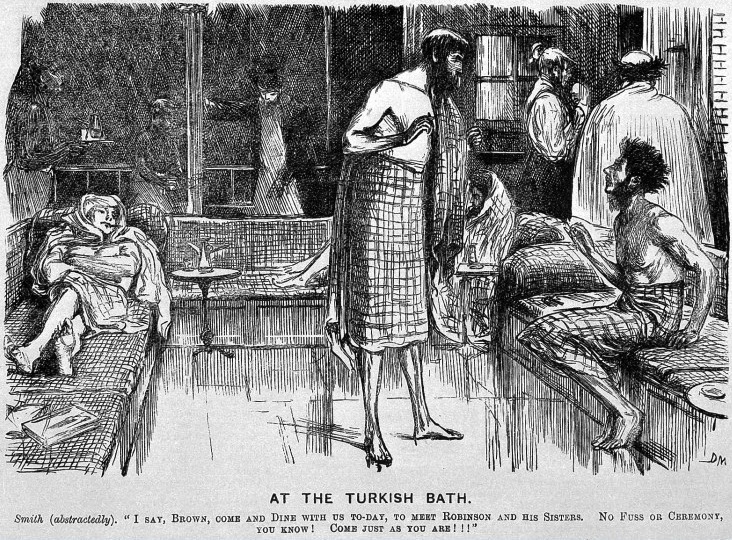
The original caption reads: "Smith, abstractedly, 'I say, Brown, come and dine with us to-day, to meet Robinson and his sisters. No fuss or ceremony, you know. Come just as you are!!!'" (Punch, Vol. 50 (1866): 220.
But perhaps the area into which he sheds most new light is social history. After looking at the history of the baths themselves, the early controversies surrounding them, and the various sectors of society for which they catered, he turns to "The World of the Bather," with an opening chapter on women. At first it seems as if their role was small. Of the more than six hundred baths that he considers, just over a hundred of those open to the general public could be used to some extent by women, and far fewer were run by women. They might have separate facilities or be restricted to certain sessions; equal access was rare. But women too contributed to their success, often involved in some aspect of them, for example as "shampooers" (in which capacity they earned far less than their male equivalents) — and, when they were patrons themselves, thoroughly enjoying the experience. The décor in these segregated areas was likely to be more feminine, even if only to compensate for their smaller scale, and special provision was sometimes made for Jewish women's ritual cleansing under running water. Turkish Bath parties started in New York in the 1890s (yes, Shifrin covers a numbers of overseas baths as well), and were apparently lively affairs rather like today's hen parties.
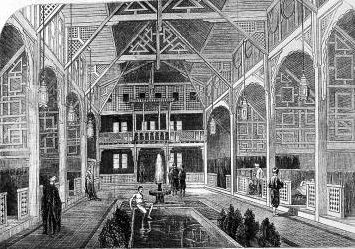
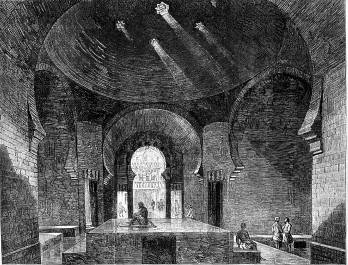
Left:The cooling room in the Turkish Baths in Jermyn-Street. Right: The hot-chamber. Illustrated London News 42 (26 July 1862): 96. Click on the images for more information.
The chapter on the baths as possible "sites of sex and sociablity" carries the suggestion of intimacy and conviviality further, and will be welcomed by many searching for evidence of the gay scene as it began to emerge in these years, particularly around the turn of the century and in the early twentieth century. Shifrin meets the difficulties here with admirable caution and exactly the "rigour" he himself recommends, pointing out the dangers of extracting reliable information from fictional accounts such as Trollope's in his short story "The Turkish Bath," first published in St Paul's Magazine in 1869. Set in one of the Jermyn Street baths (there were actually two establishments here), this story has been the subject of apparently quite ill-informed critical debate. A couple of critics, for example, have made much of the steamy atmosphere there, when in fact no steam room existed. But it does seem that, as time went by, the baths became steamy in another sense. If not in the Victorian period, then at least from around the second decade of the twentieth century, they did offer a safe haven to members of "the queer constituency." In general, other customers seem not to have begrudged them the relative privacy of the curtained cubicles with which the later baths were usually provided.
We no longer see towel-clad billboard men (or "human directionals") advertising Turkish baths. These Victorian-style facilities are disappearing fast: only twelve were left here in 2014, when Shifrin was writing. With more sophisticated washing amenities at home, more medical and alternative health treatments for chronic pain, and the popularity of the sauna, the future of the Turkish bath might seem bleak indeed. But Shifrin manages to end on a cheery note, mentioning several campaigns to save local baths, notably those in Manchester which won the first BBC2 Restoration Award of 2003. He also gives us an update on the cooling room with the stalactite cornice, used as an illustration in the glossary: it has now been recycled as part of a 1990s restaurant in Bishopsgate, and looks very exotic and inviting. This brings home the need to preserve what is left of this engaging part of our architectural and social heritage, and suggests how much it can enrich our environment today. Amply and beautifully illustrated, Shifrin's wide-ranging book looks to the future as well as being a unique reminder of things past.
Related Material
- Victorian Turkish Baths: Their Origin, Development, and Gradual Decline
- A Beautiful book — Susan Guralnik’s Victorian Web review of Victorian Turkish Baths
- A Prosaic but Useful Service: Bathhouses and Washhouses, an Idea Whose Time Had Come (scroll down for section on Turkish Baths)
Source
Shifrin, Malcolm. Victorian Turkish Baths. Swindon: Historic England, 2015. Hardback. xviii + 366 pp. ISBN 978-1-84802-230-0. £40.00
Created 15 June 2015